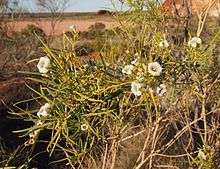Duboisia hopwoodii
| Duboisia hopwoodii | |
|---|---|
 | |
| Scientific classification | |
| Kingdom: | Plantae |
| (unranked): | Angiosperms |
| (unranked): | Eudicots |
| (unranked): | Asterids |
| Order: | Solanales |
| Family: | Solanaceae |
| Genus: | Duboisia |
| Species: | D. hopwoodii |
| Binomial name | |
| Duboisia hopwoodii (F.Muell.) F.Muell. | |
| Synonyms | |
|
Anthocercis hopwoodii F.Muell. | |
Duboisia hopwoodii is a shrub native to the arid interior region of Australia. Common names include pituri, pitchuri thornapple or pitcheri.[1] It has an erect habit, usually growing to between 1 and 3 metres in height and has long, narrow leaves.[2][3] Flowers are white and bell-shaped with violet-striped throats.[3] These appear between June and November in the species native range followed by purple-black, rounded berries which are 3 to 6 mm in diameter.[1][2]
Pituri
Indigenous Australians mix the dried leaves of a small population of D. hopwoodii growing around the Mulligan River with wood ash to make a variety of pituri, the traditional Aboriginal chewing mixture. D. hopwoodii plants from this region are high in nicotine and low in the much more toxic drug nornicotine, whereas those found in some other parts of Australia can have very high levels of nornicotine and are sometimes used to contaminate water holes and stun animals to help in hunting.[4] The paleontologist Dr Gavin Young named the fossil agnathan Pituriaspis doylei after the plant, as he thought he might be hallucinating, as though under the effects of pituri, upon viewing the fossil fish's bizarre form.[5]
Taxonomy
The species was first formally described by botanist Ferdinand von Mueller in 1861 in Fragmenta Phytographiae Australiae and given the name Anthocercis hopwoodii. In 1876, von Mueller transferred the species to the genus Duboisia.[6]
References
- 1 2 "Duboisia hopwoodii ". Electronic Flora of South Australia Fact Sheet. State Herbarium of South Australia. Retrieved 2010-03-09.
- 1 2 "Duboisia hopwoodii". FloraBase. Western Australian Government Department of Parks and Wildlife.
- 1 2 Gardner, C.A. (1981). Wildflowers of Western Australia. Perth: St George Books. ISBN 086778007X.
- ↑ Littlejohn, Katie. "Duboisia hopwoodii - Pituri Bush". Retrieved 2010-03-03.
- ↑ Long, John A. The Rise of Fishes: 500 Million Years of Evolution. Baltimore: The Johns Hopkins University Press, 1996. ISBN 0-8018-5438-5
- ↑ "Duboisia hopwoodii". Australian Plant Name Index (APNI), IBIS database. Centre for Plant Biodiversity Research, Australian Government, Canberra. Retrieved 2010-03-09.